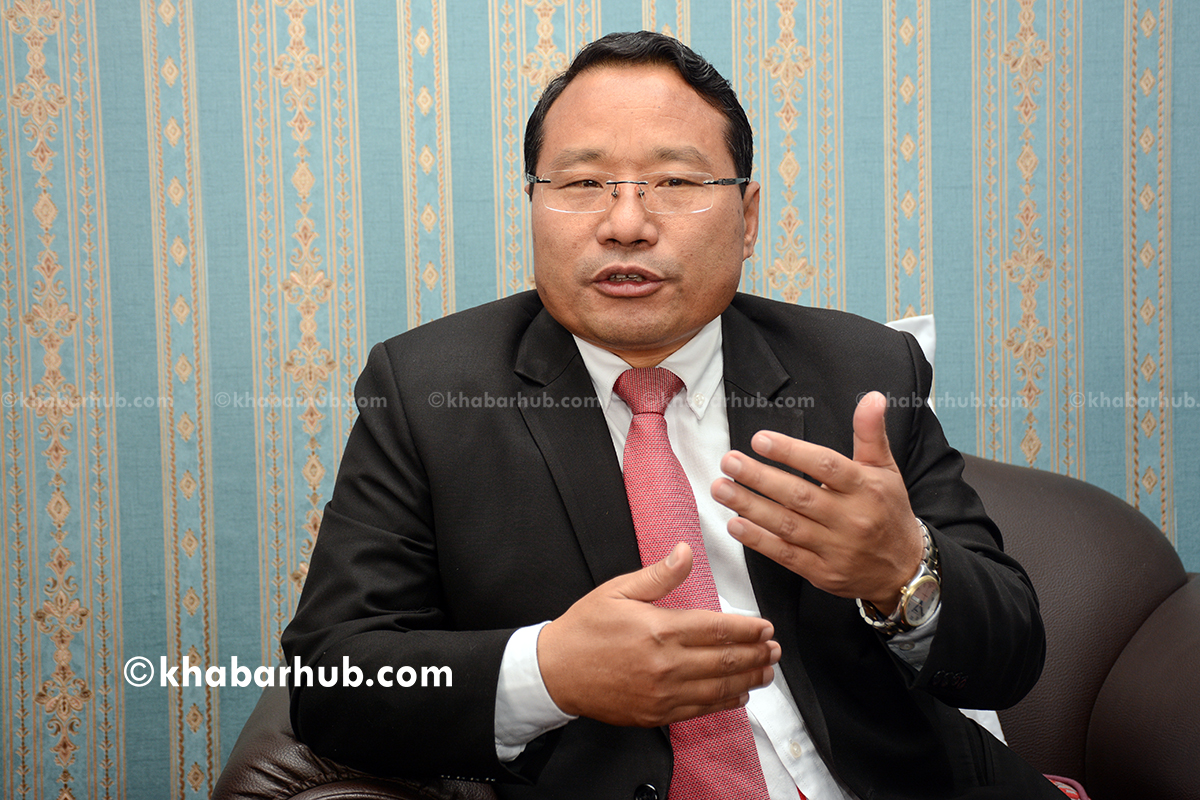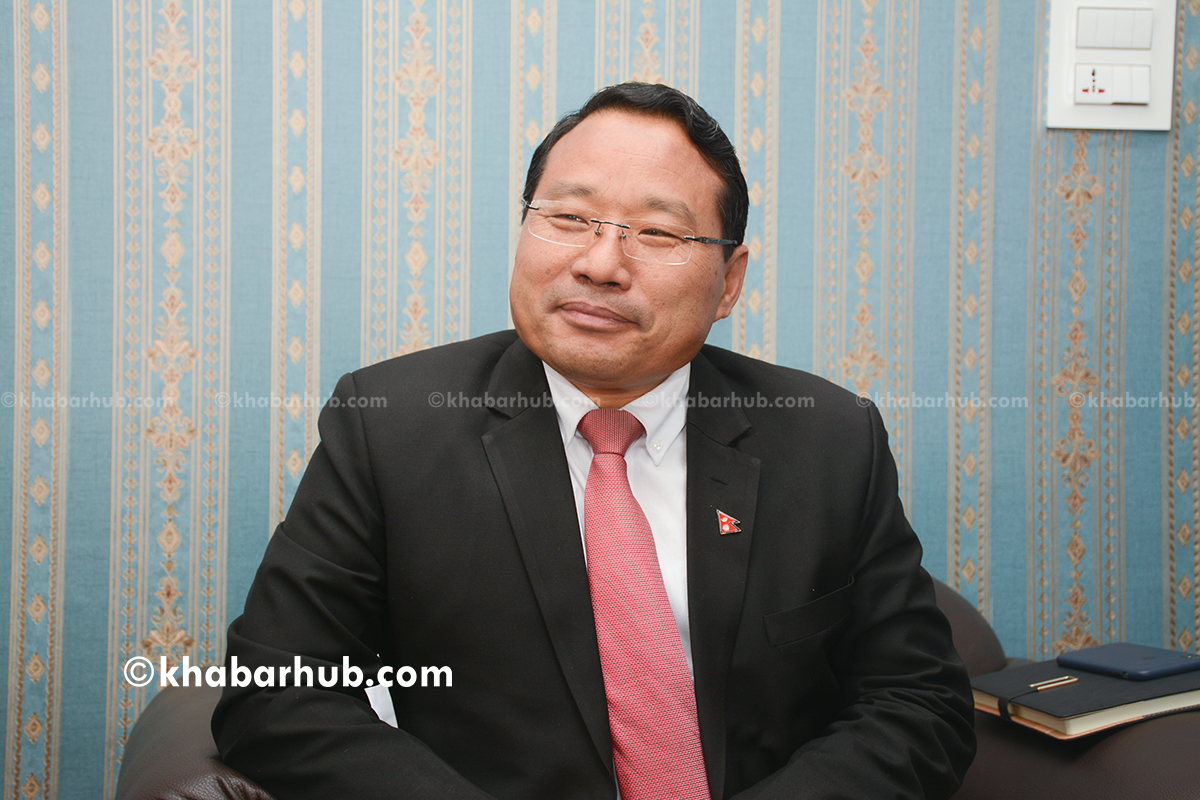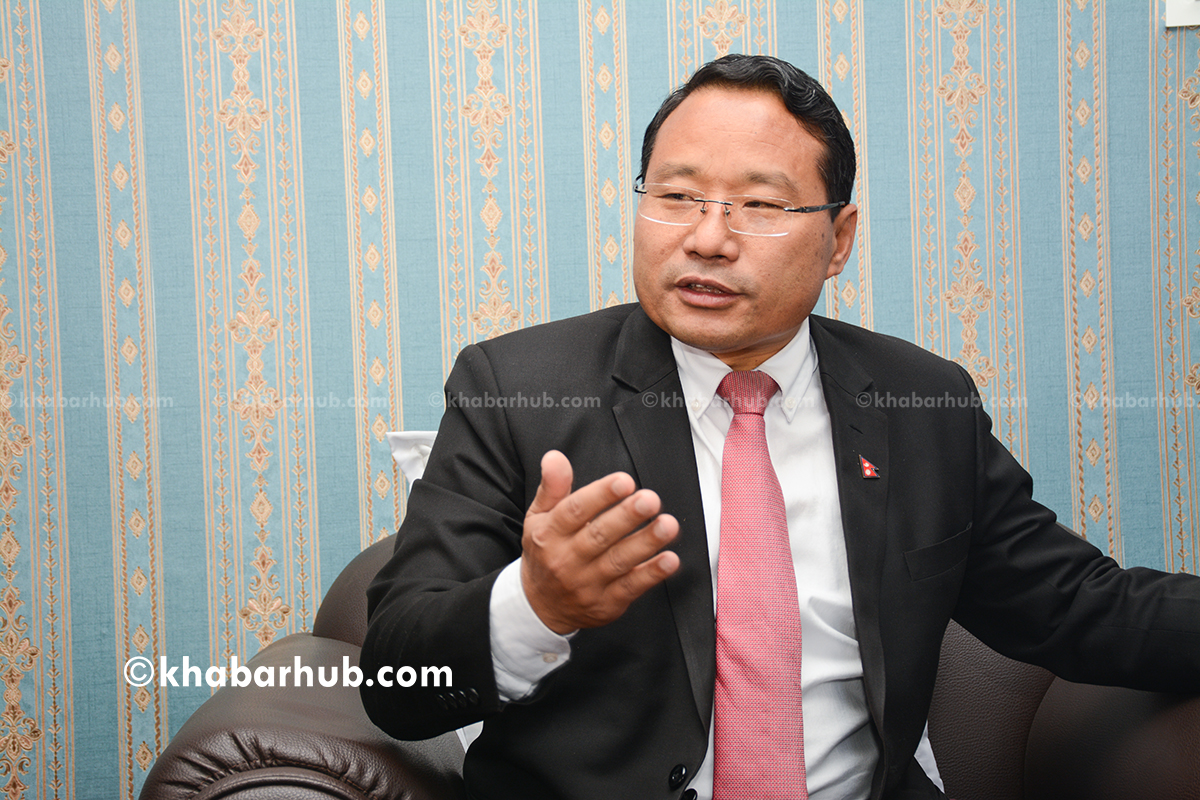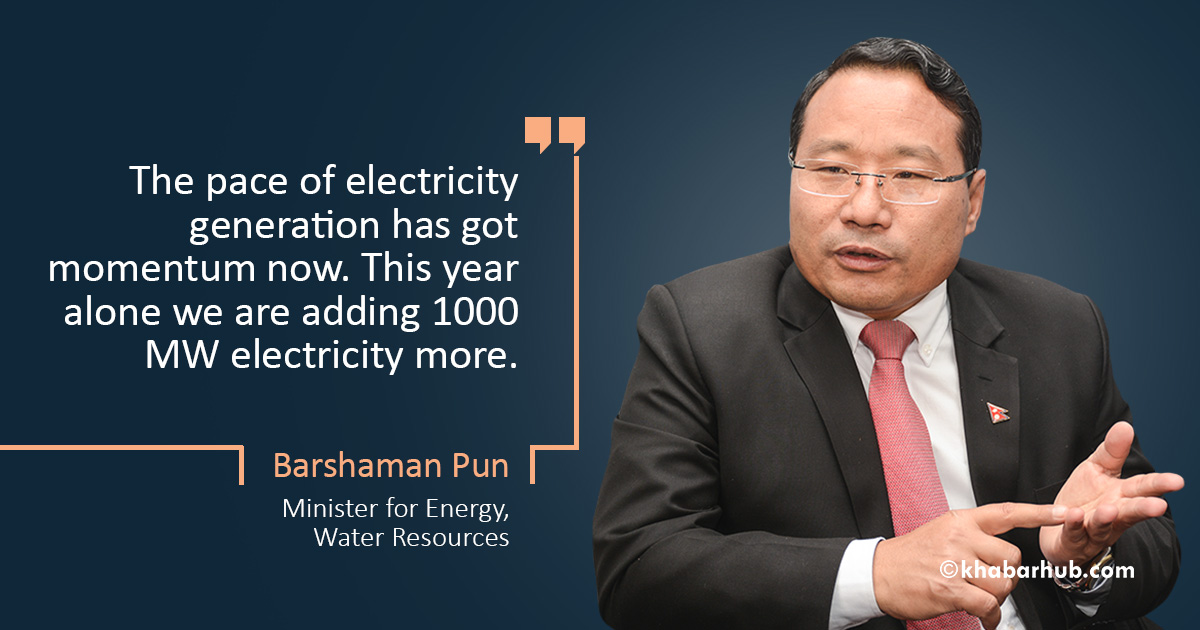Minister for Energy, Water Resource and Irrigation, Barshaman Pun has traveled a lot in his life till attaining the current post. Transferring his role from a teacher cum politician to a rebel, he proved himself a man of importance in a peaceful transition later. One of the game changers of Nepal Communist Party, Pun is one of few lucky ministers to get a chance to pursue his vision of the energy sector to its destination. Recently, Khabarhub talked to him about his visions, plans, and programs for the ministry he is in.
Here are the excerpts of the interview Ishwar Dev Khanal, on behalf of Khabarhub, took with Minister Pun.
Energy is regarded as a pre-requisite for development in Nepal. As the Minister for Energy, Water Resource and Irrigation of this country which is so rich in water resources, how are you executing your responsibilities?
At the time of taking the responsibility of the Ministry, I came up with vision paper. My vision paper included the promises made in the election manifesto of Nepal Communist Party and the government’s perspective on the issues related to my ministry.
The paper has mentioned 1918-1928 as the energy decade. We aim to attain two-digit economic growth. The growth is impossible without industrial development. Energy supply is the pre-requisite for industrial development. The study shows that for two-digit growth, we need 10 thousand Megawatt in 10 years. We have a run-of-river project, we do not have the project with reservoirs. We are working to generate 15000 megawatts in 10 years so that we can ensure the availability of 10,000-megawatt electricity throughout the year.

I have been working to promote professionalism and modernization in agriculture which is possible only after ensuring the irrigation facility to all arable land. To make the nation self-dependent in food, I have been working out in the possibility of big river diversion that can contribute to irrigation. Gradually, the labor is bearing fruits.
Citing the insufficiency of internal resources, experts say that foreign investment has to be arranged for it. They mention that our legal provision and the investment policy is not suitable for it. Is it so?
For the development of a nation, first, we should give priority to our own capital. Secondly, we have to arrange for foreign aid when the national capital or resources do not suffice; provided the internal source and foreign aid are not sufficient for it, as the third alternative, we should open door for foreign loan and the fourth priority has to be welcoming the external investment if all other attempts mentioned above work effectively. Thus, investment is a pivotal factor.
We have to encourage the investors inside the country and attract foreign investors ensuring them that their investment is safe and secure in Nepal. For this, the investment-friendly statutes have to be there supporting the government claims. Actually we have already met the legal requirements in this regard. We have made it clear that the profit or principal amount can be taken back by the investors. We have amended the statutes like the laws relating to investment board, industrial investment promotion.
In the investment sector, there are more Chinese and Indian investors showing interest in the energy sector. Korean investment has come for Upper Trishuli 3 A. Similarly, Japanese and American investors have also shown their interest and are approaching for the projects.
The hydroelectricity sector has drawn bigger investors towards it. Once there is enough investment, one has to explore the market for it. Currently, the government has been importing the electricity generated inside the country through Nepal Electricity Authority.
We have been expanding the market even inside the country. We are encouraging our domestic customers to use electrical appliances, we have supplied electricity to the bigger industries like cement and rod industries.
We have made an energy banking agreement with India. Bangladesh has agreed to buy electricity from us. GMR the company working on 900 MW Upper Karnali project, has signed a PPA with Bangladesh to sell it 500 megawatts.

Once the Council of Ministers of Bangladesh gives its approval, it shall enter the implementation phase. In this way, we have explored the Indian and Bangladeshi markets. We have ensured the investor especially the safety of their investment and their right to take the profit back to their country; and have also explored the market required.
What are the projects you have selected to generate 15,000-megawatt electricity?
In 108 years, we have generated 1200 MW. The pace of electricity generation has got momentum now. This year alone we are adding 1000 MW electricity more. In the coming 4 years, we will generate 5000 MW; these projects are under construction. From the private and government sectors, we are working to generate 15000 MW in 10 years. The power purchase agreement (PPA) for nearly 7000 MW is already complete. The private sector has taken a license to construct projects generating 15000 MW. The capacity of the projects in which the feasibility study is done from the private and government sectors has reached 32000 MW. So, we are sure to get 5000 MW in 5 years. Yes, it’s a bit challenging to meet 15000 MW in 10 years; but, we are working hard in this direction.
Are we producing electricity with the plan of exporting the electricity or it’s for internal consumption?
Firstly, we will consume the electricity ourselves, electricity is like a raw material. It is said that electricity worth 1 rupee can enhance the production worth Rs 5-7. So, our prime concern is in making Rs 5 from 1 rupee investment.
We want to use electricity in the production of goods and services. Our production is more in summer whereas it shrinks in winter. When we generate 15000 MW in the rainy season it shrinks to 10000 MW in winter. We need 10000 MW in the coming 10 years. So, I believe we shall be consuming most of our production in the coming 10 years.
But, we are thinking about exporting excess electricity to India or Bangladesh. India is generating 100000 MW electricity. When India goes solar, it needs our electricity. Solar panels work during the sunny period, but for the evening and cold seasons, more electricity is needed. The technology of storing solar energy is more expensive than hydroelectricity. We can store the water during day time and generate electricity at night and sell it to needy ones.
Indians have understood it. Generating electricity from thermal coal also takes time. The advantage of water is whenever it’s turned on, the electricity is generated. Our production can have a good market in India and Bangladesh. They generate more electricity in winter, we generate more electricity in summer. We have thought about exporting it in the regional market though on a small scale.
Does the regional market mean India and Bangladesh only or there is the possibility of expanding it to other countries?
It can be expanded up to Sri Lanka, Myanmar, and Thailand as well.
But, we often fail to generate electricity in time or do not complete the project in the designated period. Even the projects with foreign investment are unable to overcome these problems here. How is the Ministry thinking about coping with such hazards?
We have some problems with it, but not much serious now. Some projects like Chameliya, Upper Trishuli 3 A, Kulekhani 3rd are already in track. Perhaps you mean the projects like West Seti.
The West Seti Hydropower Project is now with the Investment Board. Although the project was handed to a Chinese company in the beginning, after the cancellation of the contract with that company, it was kept in ‘show-cause’ status. Some other companies including, American, Qatari, Japanese have shown interest for investment, we are studying about it.
The compensation distribution for the land needed for the Budhi Gandaki Project is going on. We plan to finish the task this week. Hydroelectricity Investment and Development Company Limited (HIDCL) Nepal and Power China Corporation have signed an agreement for 756 MW Tamor Project; the construction has already started.
Both companies have made a general agreement to work on a 156 MW Madi project.
We have planned to go for other bigger projects like the 1061 MW Upper Arun project by taking some loans from the World Bank. We have initiated the study to launch a 565 MW Dudhkoshi Reservoir project taking a loan from ADB. NEA will handle the project.
Japan Government, through JICA, has shown its interest in the 410MW Nal Sing Gadh project. Japan is most likely to carry it on. The Provident Fund has taken the lead of the construction of the 680 MW Betan Karnali Hydropower project. Political stability has really clicked the hydro projects at their best.
However, don’t you feel there is a problem somewhere?
We had a transition of 10 years. More than the government the projects were selected or decided at the interest of the Prime Minister, then. They had to give output in 5 years, and the situation made it so that no government could function so long. The ministers only declared the programs. There was always an excuse for not meeting the target, ‘lack of enough time.’ But now the situation is different. The minister to declare the program has the responsibility to arrange for the budget as well. Not only this, lame excuses do not work much. The government now cannot make ‘lame’ excuses, even citing the budget. Previously, there used to be an informal economy, now the situation is much better.
What’s your opinion about Pancheswor and Upper Karnali? Citing the trend of holding licenses there is a saying that ‘rivers in the bag’ (jhola ma khola). What do you think of it?
GMR (Grandhi Mallikarjuna Rao) group has promised to complete the project signing PPA with Bangladesh very soon. Provided he doesn’t complete it on time, we will repeal its permission and go for alternatives. If it can get a market in Bangladesh, that’s positive. If a private company succeeds to do something the government was unable to do it for various reasons, it’s positive.
About Pancheswor, a meeting is scheduled in Delhi in a few days, we will settle the issue even holding talk at the political level. The issue has come under the notice of the PM of both countries. We are ready to address the dispute if there is anything like that. One of the major problems is related to Lower Sharada, a place 160 km down Pancheswor.
We call it Mahakali dam and they call it Lowe Sharada. There is a debate about the distribution of water over there. We have said that water allocation should be 50-50 on both sides, they want it to be for them alone as they have been using it so far.
‘Rivers in the bag’ has really defamed the hydro industry itself. Previously, the procedure for getting a license for the hydro-project was too simple. Many people abused the loopholes; but now with the strict regulations in this issue, the problem is solved. Now, there are more than 110 such licenses in government basket and 220 such licenses are repealed.

It is said that foreigners are showing interest in the energy and water resource sector. What’s the reality?
Climate change has created multiple hazards worldwide. There is a scarcity of pure water. It’s true that people are eyeing Nepal’s water as well. Provided we are able to cash it, we can prosper easily.
If we make big dams and hold the water of Nepali rivers, it can reduce flood events in India. Big reservoir projects will certainly benefit India as well. We are discussing it when we meet the counterparts both at minister level and higher level too.
Besides, Bangladesh can also benefit from us. So, we want to include Bangladesh as well. We have asked the financiers of India, China and Bangladesh to come for investment in hydroelectricity in Nepal.
A few days ago, we inaugurated Upper Trishuli 3 A which will contribute 7% in the reduction of our import. It will generate electricity worth 4 billion rupees. We had imported the electricity worth 24 billion last year.
We can replace the import from India this year provided we succeed in adding 1000 MW in the national power grid. This will, definitely, reduce the trade deficit.
We have been investing 48 billion in gas import which can be replaced as well.
We will expand electricity coverage throughout the country in 2 years. Now, 88% of people have access to electricity, in 3 years from now, everyone will have access to it.
What about the condition of irrigation?
Even in irrigation, large scale land irrigation is possible only through the diversion of big rivers. Some projects like Kali Gandaki Tinau Diversion, Sunkoshi Kamal, and Sunkoshi Marine Diversion are under study. Completion of such a project will provide enough irrigation facilities required for Terai-Madhesh. We are also working on operating electricity authority at the province level.
Are there any activities for the capacity building and quality improvement of the Nepal Electricity Authority in the pipeline?
Definitely, we are working on it too. We have drafted the electricity authority and water resource act. We are defining the ways of conservation, distribution, and usage of water under federal modality. We have launched the ‘Equal Opportunity for All’ campaign for electricity generation. Now, the Electricity Regulatory Commission has been founded. It will start its work soon. We have set 7 companies for the distribution of electricity in 7 provinces. We are arranging for the distribution, production, and transmission of electricity through different agencies so that the Authority can work more effectively.
Nepal is said to be an agricultural country, due to lack of proper irrigation facilities, we are bound to import food grains from outside. How are you planning to address it?
For the irrigation of 40000 hectors in Saptari and Sarlahi, we have initiated the installation of 1000 tube wells. This is a modern pilot project. We are planning to launch a lift irrigation system in the hills. Our statistics say that 300000 hectors of land at riverbank is still lying barren. We are launching a lift irrigation system to arrange for such land as well.









Comment